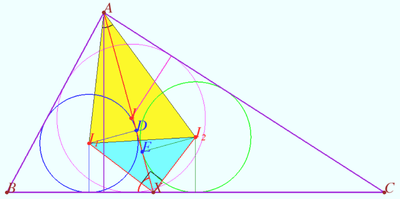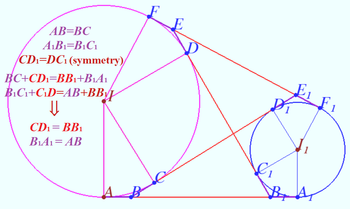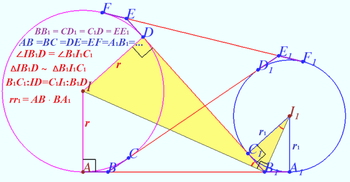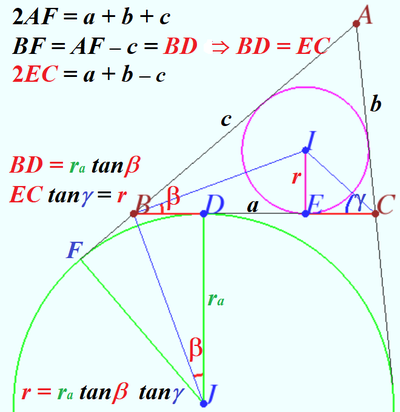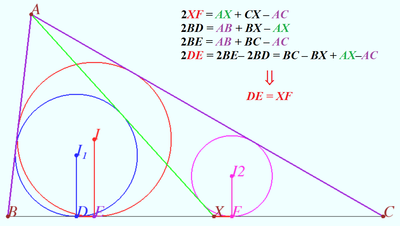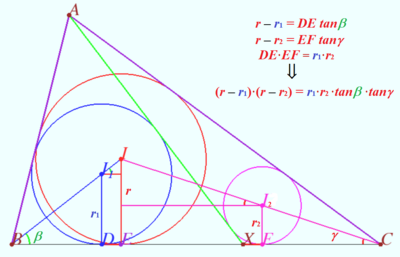Difference between revisions of "2018 AIME I Problems/Problem 13"
(→Solution 3a) |
(→Solution 5 (Barybash)) |
||
| (17 intermediate revisions by 5 users not shown) | |||
| Line 5: | Line 5: | ||
First note that <cmath>\angle I_1AI_2 = \angle I_1AX + \angle XAI_2 = \frac{\angle BAX}2 + \frac{\angle CAX}2 = \frac{\angle A}2</cmath> is a constant not depending on <math>X</math>, so by <math>[AI_1I_2] = \tfrac12(AI_1)(AI_2)\sin\angle I_1AI_2</math> it suffices to minimize <math>(AI_1)(AI_2)</math>. Let <math>a = BC</math>, <math>b = AC</math>, <math>c = AB</math>, and <math>\alpha = \angle AXB</math>. Remark that <cmath>\angle AI_1B = 180^\circ - (\angle I_1AB + \angle I_1BA) = 180^\circ - \tfrac12(180^\circ - \alpha) = 90^\circ + \tfrac\alpha 2.</cmath> Applying the Law of Sines to <math>\triangle ABI_1</math> gives <cmath>\frac{AI_1}{AB} = \frac{\sin\angle ABI_1}{\sin\angle AI_1B}\qquad\Rightarrow\qquad AI_1 = \frac{c\sin\frac B2}{\cos\frac\alpha 2}.</cmath> Analogously one can derive <math>AI_2 = \tfrac{b\sin\frac C2}{\sin\frac\alpha 2}</math>, and so <cmath>[AI_1I_2] = \frac{bc\sin\frac A2 \sin\frac B2\sin\frac C2}{2\cos\frac\alpha 2\sin\frac\alpha 2} = \frac{bc\sin\frac A2 \sin\frac B2\sin\frac C2}{\sin\alpha}\geq bc\sin\frac A2 \sin\frac B2\sin\frac C2,</cmath> with equality when <math>\alpha = 90^\circ</math>, that is, when <math>X</math> is the foot of the perpendicular from <math>A</math> to <math>\overline{BC}</math>. In this case the desired area is <math>bc\sin\tfrac A2\sin\tfrac B2\sin\tfrac C2</math>. To make this feasible to compute, note that <cmath>\sin\frac A2=\sqrt{\frac{1-\cos A}2}=\sqrt{\frac{1-\frac{b^2+c^2-a^2}{2bc}}2} = \sqrt{\dfrac{(a-b+c)(a+b-c)}{4bc}}.</cmath> Applying similar logic to <math>\sin \tfrac B2</math> and <math>\sin\tfrac C2</math> and simplifying yields a final answer of <cmath>\begin{align*}bc\sin\frac A2\sin\frac B2\sin\frac C2&=bc\cdot\dfrac{(a-b+c)(b-c+a)(c-a+b)}{8abc}\\&=\dfrac{(30-32+34)(32-34+30)(34-30+32)}{8\cdot 32}=\boxed{126}.\end{align*}</cmath> | First note that <cmath>\angle I_1AI_2 = \angle I_1AX + \angle XAI_2 = \frac{\angle BAX}2 + \frac{\angle CAX}2 = \frac{\angle A}2</cmath> is a constant not depending on <math>X</math>, so by <math>[AI_1I_2] = \tfrac12(AI_1)(AI_2)\sin\angle I_1AI_2</math> it suffices to minimize <math>(AI_1)(AI_2)</math>. Let <math>a = BC</math>, <math>b = AC</math>, <math>c = AB</math>, and <math>\alpha = \angle AXB</math>. Remark that <cmath>\angle AI_1B = 180^\circ - (\angle I_1AB + \angle I_1BA) = 180^\circ - \tfrac12(180^\circ - \alpha) = 90^\circ + \tfrac\alpha 2.</cmath> Applying the Law of Sines to <math>\triangle ABI_1</math> gives <cmath>\frac{AI_1}{AB} = \frac{\sin\angle ABI_1}{\sin\angle AI_1B}\qquad\Rightarrow\qquad AI_1 = \frac{c\sin\frac B2}{\cos\frac\alpha 2}.</cmath> Analogously one can derive <math>AI_2 = \tfrac{b\sin\frac C2}{\sin\frac\alpha 2}</math>, and so <cmath>[AI_1I_2] = \frac{bc\sin\frac A2 \sin\frac B2\sin\frac C2}{2\cos\frac\alpha 2\sin\frac\alpha 2} = \frac{bc\sin\frac A2 \sin\frac B2\sin\frac C2}{\sin\alpha}\geq bc\sin\frac A2 \sin\frac B2\sin\frac C2,</cmath> with equality when <math>\alpha = 90^\circ</math>, that is, when <math>X</math> is the foot of the perpendicular from <math>A</math> to <math>\overline{BC}</math>. In this case the desired area is <math>bc\sin\tfrac A2\sin\tfrac B2\sin\tfrac C2</math>. To make this feasible to compute, note that <cmath>\sin\frac A2=\sqrt{\frac{1-\cos A}2}=\sqrt{\frac{1-\frac{b^2+c^2-a^2}{2bc}}2} = \sqrt{\dfrac{(a-b+c)(a+b-c)}{4bc}}.</cmath> Applying similar logic to <math>\sin \tfrac B2</math> and <math>\sin\tfrac C2</math> and simplifying yields a final answer of <cmath>\begin{align*}bc\sin\frac A2\sin\frac B2\sin\frac C2&=bc\cdot\dfrac{(a-b+c)(b-c+a)(c-a+b)}{8abc}\\&=\dfrac{(30-32+34)(32-34+30)(34-30+32)}{8\cdot 32}=\boxed{126}.\end{align*}</cmath> | ||
| + | *Notice that we truly did minimize the area for <math>[A I_1 I_2]</math> because <math>b, c, \angle A, \angle B, \angle C</math> are all constants while only <math>\sin \alpha</math> is variable, so maximizing <math>\sin \alpha</math> would minimize the area. | ||
| − | ==Solution 2 (A lengthier, but less trigonometric approach)== | + | ==Solution 2 (Similar to Official MAA)== |
| + | It's clear that <math>\angle I_{1}AI_{2}=\frac{1}{2}\angle BAX+\frac{1}{2}\angle CAX=\frac{1}{2}\angle A</math>. Thus <cmath>\begin{align*} AI_{1}I_{2}&=\frac{1}{2}\cdot AI_{1}\cdot AI_{2}\cdot\sin\angle I_{1}AI_{2} \\ &=\frac{1}{2}\cdot AI_{1}\cdot AI_{2}\cdot\sin\left(\frac{1}{2}\angle A\right).\end{align*}</cmath> By the Law of Sines on <math>\triangle AI_{1}B</math>, <cmath>\frac{AI_{1}}{\sin\left(\frac{1}{2}\angle B\right)}=\frac{AB}{\sin\angle AI_{1}B}.</cmath> Similarly, <cmath>\frac{AI_{2}}{\sin\left(\frac{1}{2}\angle C\right)}=\frac{AC}{\sin\angle AI_{2}C}.</cmath> It is well known that <cmath>\angle AI_{1}B=90+\frac{1}{2}\angle AXB~~~\text{and}~~~\angle AI_{2}C=90+\frac{1}{2}\angle AXC.</cmath> Denote <math>\alpha=\frac{1}{2}\angle AXB</math> and <math>\theta=\frac{1}{2}\angle AXC</math>, with <math>\alpha+\theta=90^{\circ}</math>. Thus <math>\sin\alpha=\cos\theta</math> and <cmath>\begin{align*}\frac{AI_{1}}{\sin\left(\frac{1}{2}\angle B\right)}=\frac{AB}{\sin\angle AI_{1}B}\Longrightarrow\frac{AB}{\sin\left(90^{\circ}+\alpha\right)}\Longrightarrow\frac{AB}{\cos\alpha} \\\frac{AI_{2}}{\sin\left(\frac{1}{2}\angle C\right)}=\frac{AC}{\sin\angle AI_{2}C}\Longrightarrow\frac{AC}{\sin\left(90^{\circ}+\theta\right)}\Longrightarrow\frac{AC}{\cos\theta}\Longrightarrow\frac{AC}{\sin\alpha}.\end{align*}</cmath> Thus <cmath>AI_{1}=\frac{AB\sin\left(\frac{1}{2}\angle B\right)}{\cos\alpha}~~~\text{and}~~~AI_{2}=\frac{AC\sin\left(\frac{1}{2}\angle C\right)}{\sin\alpha}</cmath> so <cmath>\begin{align*}[AI_{1}I_{2}]&=\frac{1}{2}\cdot AI_{1}\cdot AI_{2}\cdot\sin\left(\frac{1}{2}\angle A\right) \\ &=\frac{AB\sin\left(\frac{1}{2}\angle B\right)\cdot AC\sin\left(\frac{1}{2}\angle C\right)\cdot\sin\left(\frac{1}{2}\angle A\right)}{2\sin\alpha\cos\alpha} \\ &=\frac{AB\sin\left(\frac{1}{2}\angle B\right)\cdot AC\sin\left(\frac{1}{2}\angle C\right)\cdot\sin\left(\frac{1}{2}\angle A\right)}{\sin(2\alpha)}.\end{align*}</cmath> We intend to minimize this expression, which is equivalent to maximizing <math>\sin(2\alpha)</math>, and that occurs when <math>\alpha=45^{\circ}</math>, or <math>\angle AXB=90^{\circ}</math>. Ergo, <math>X</math> is the foot of the altitude from <math>A</math> to <math>\overline{BC}</math>. In that case, we intend to compute <cmath>AB\cdot AC\cdot\sin\left(\frac{1}{2}\angle B\right)\cdot\sin\left(\frac{1}{2}\angle C\right)\cdot\sin\left(\frac{1}{2}\angle A\right).</cmath> Recall that <cmath>\sin\left(\frac{1}{2}\angle B\right)=\sqrt{\frac{1-\cos\angle B}{2}}</cmath> and similarly for angles <math>C</math> and <math>A</math>. Applying the Law of Cosines to each angle of <math>\triangle ABC</math> gives <cmath>\begin{align*}\angle B&:\cos\angle B=\frac{30^{2}+32^{2}-34^{2}}{2\cdot 30\cdot 32}=\frac{2}{5} \\ \angle C&:\cos\angle C=\frac{32^{2}+34^{2}-30^{2}}{2\cdot 32\cdot 34}=\frac{10}{17} \\ \angle A&:\cos\angle A=\frac{30^{2}+34^{2}-32^{2}}{2\cdot 30\cdot 34}=\frac{43}{85}.\end{align*}</cmath> Thus <cmath>\begin{align*}\sin\left(\frac{1}{2}\angle B\right)=\sqrt{\frac{1-\tfrac{2}{5}}{2}}=\sqrt{\frac{3}{10}} \\ \sin\left(\frac{1}{2}\angle C\right)=\sqrt{\frac{1-\tfrac{10}{17}}{2}}=\sqrt{\frac{7}{34}} \\ \sin\left(\frac{1}{2}\angle A\right)=\sqrt{\frac{1-\tfrac{43}{85}}{2}}=\sqrt{\frac{21}{85}}.\end{align*}</cmath> Thus the answer is <cmath>\begin{align*} & 30\cdot 34\cdot\sqrt{\frac{3}{10}\cdot\frac{7}{34}\cdot\frac{21}{85}} \\ =&~30\cdot 34\cdot\sqrt{\frac{3}{2\cdot 5}\cdot\frac{7}{2\cdot 17}\cdot\frac{3\cdot 7}{5\cdot 17}} \\ =&~30\cdot 34\cdot\frac{3\cdot 7}{2\cdot 5\cdot 17} \\ =&~(2\cdot 3\cdot 5)\cdot(2\cdot 17)\cdot\frac{3\cdot 7}{2\cdot 5\cdot 17} \\ =&~2\cdot 3^{2}\cdot 7 \\ =&~\boxed{126}.\end{align*}</cmath> | ||
| + | |||
| + | |||
| + | ==Solution 3 (A lengthier, but less trigonometric approach)== | ||
First, instead of using angles to find <math>[AI_1I_2]</math>, let's try to find the area of other, simpler figures, and subtract that from <math>[ABC]</math>. However, to do this, we need to be able to figure out the length of the inradii, and so, we need to find <math>AX</math>. | First, instead of using angles to find <math>[AI_1I_2]</math>, let's try to find the area of other, simpler figures, and subtract that from <math>[ABC]</math>. However, to do this, we need to be able to figure out the length of the inradii, and so, we need to find <math>AX</math>. | ||
| Line 40: | Line 45: | ||
https://www.youtube.com/watch?v=sT-wxV2rYqs | https://www.youtube.com/watch?v=sT-wxV2rYqs | ||
| − | ==Solution | + | ==Solution 4 (Geometry only)== |
[[File:2018 AIME I 13.png|400px|right]] | [[File:2018 AIME I 13.png|400px|right]] | ||
Let <math>BC = a, s</math> be semiperimeter of <math>\triangle ABC, s = 48, h</math> be the height of <math>\triangle ABC</math> dropped from <math>A.</math> | Let <math>BC = a, s</math> be semiperimeter of <math>\triangle ABC, s = 48, h</math> be the height of <math>\triangle ABC</math> dropped from <math>A.</math> | ||
| Line 76: | Line 81: | ||
Last is evident, the claim has been proven. | Last is evident, the claim has been proven. | ||
| − | ''' | + | '''vladimir.shelomovskii@gmail.com, vvsss''' |
| − | ==Solution | + | ==Solution 4a== |
[[File:2018 AIME I 13e.png|350px|right]] | [[File:2018 AIME I 13e.png|350px|right]] | ||
| Line 89: | Line 94: | ||
Using diagrams, we can recall known facts and using those facts for making sequence of equations. | Using diagrams, we can recall known facts and using those facts for making sequence of equations. | ||
| − | + | <cmath>\frac {(r-r_1)\cdot (r-r_2)}{r_1 \cdot r_2} =\tan\beta \tan\gamma.</cmath> | |
The twice area of <math>\triangle ABC</math> is | The twice area of <math>\triangle ABC</math> is | ||
| Line 97: | Line 102: | ||
Therefore <cmath>r_1 + r_2 - \frac{2 r_1 r_2 }{h} = r.</cmath> | Therefore <cmath>r_1 + r_2 - \frac{2 r_1 r_2 }{h} = r.</cmath> | ||
| − | [[File:2018 AIME I 13d.png| | + | |
| − | ''' | + | [[File:2018 AIME I 13g.png|400px|right]] |
| + | [[File:2018 AIME I 13d.png|400px]] | ||
| + | [[File:2018 AIME I 13f.png|400px]] | ||
| + | |||
| + | '''vladimir.shelomovskii@gmail.com, vvsss''' | ||
| + | |||
| + | |||
| + | == Solution 5 (Barybash) == | ||
| + | |||
| + | We use barycentric coordinates with <math>A=(1,\,0,\,0)</math>, <math>B=(0,\,1,\,0)</math>, <math>C=(0,\,0,\,1)</math>, <math>a:=BC</math>, <math>b:=CA</math>, <math>C:=AB</math>. Let <math>X=:(0,\,t,\,1-t)</math> and <math>d:=AX</math>. Then <math>\overline{XA}=(1,\,-t,\,t-1)</math> so | ||
| + | <cmath> | ||
| + | d^2=-a^2t(1-t)+b^2(1-t)+c^2t. | ||
| + | </cmath> | ||
| + | By the angle bisector theorem, the angle bisector of <math>\angle BAX</math> intersects side <math>BC</math> at | ||
| + | <cmath> | ||
| + | \frac{d}{c+d}B+\frac{c}{c+d}X=\left(0,\,\frac{d+ct}{c+d},\,\frac{c(1-t)}{c+d}\right). | ||
| + | </cmath> | ||
| + | Thus | ||
| + | <cmath> | ||
| + | I_1=(a(1-t):d+ct:c(1-t))=\left(\frac{a(1-t)}{a(1-t)+c+d},\,\frac{d+ct}{a(1-t)+c+d},\,\frac{c(1-t)}{a(1-t)+c+d}\right). | ||
| + | </cmath> | ||
| + | Similarly, | ||
| + | <cmath> | ||
| + | I_2=\left(\frac{at}{at+b+d},\,\frac{bt}{at+b+d},\,\frac{d+b(1-t)}{at+b+d}\right). | ||
| + | </cmath> | ||
| + | Hence, | ||
| + | \begin{align*} | ||
| + | \frac{[AI_1I_2]}{[ABC]}&= | ||
| + | \begin{vmatrix} | ||
| + | 1 & 0 & 0\\ | ||
| + | \frac{a(1-t)}{a(1-t)+c+d} & \frac{d+ct}{a(1-t)+c+d} & \frac{c(1-t)}{a(1-t)+c+d}\\ | ||
| + | \frac{at}{at+b+d} & \frac{bt}{at+b+d} & \frac{d+b(1-t)}{at+b+d} | ||
| + | \end{vmatrix}\\ | ||
| + | &=\frac{(d+ct)(d+b(1-t))-bct(1-t)}{(a(1-t)+c+d)(at+b+d)}\\ | ||
| + | &=\frac{d^2+d(b(1-t)+ct)}{(a(1-t)+c+d)(at+b+d)}. | ||
| + | \end{align*} | ||
| + | The denominator equals | ||
| + | \begin{align*} | ||
| + | (a(1-t)+c+d)(at+b+d)&=a^2t(1-t)+ab(1-t)+ad(1-t)+act+bc+cd+adt+bd+d^2\\ | ||
| + | &=a^2t(1-t)+ab(1-t)+ad+act+bc+cd+bd-a^2t(1-t)+b^2(1-t)+c^2t\\ | ||
| + | &=b(a+b)(1-t)+c(a+c)t+bc+d(a+b+c). | ||
| + | \end{align*} | ||
| + | Note that <math>(b(1-t)+ct)(a+b+c)=b(a+b)(1-t)+c(a+c)t+bc</math> so | ||
| + | <cmath> | ||
| + | \frac{[AI_1I_2]}{[ABC]}=\frac{d^2+d(b(1-t)+ct)}{(a(1-t)+c+d)(at+b+d)}=\frac{d}{a+b+c}, | ||
| + | </cmath> | ||
| + | which is minimized when <math>AX</math> is an altitude. By Heron, we get <math>[ABC]=96\sqrt{21}</math> so <math>AX=6\sqrt{21}</math>. Thus <math>[AI_1I_2]=\frac{96\sqrt{21}\cdot 6\sqrt{21}}{30+32+34}=\boxed{126}</math>. | ||
| + | |||
| + | - KevinYang2.71 | ||
| + | |||
| + | ==Video Solution by MOP 2024== | ||
| + | https://youtube.com/watch?v=ALzZA13PuZk | ||
==See Also== | ==See Also== | ||
Latest revision as of 21:38, 29 December 2024
Contents
Problem
Let ![]() have side lengths
have side lengths ![]() ,
, ![]() , and
, and ![]() . Point
. Point ![]() lies in the interior of
lies in the interior of ![]() , and points
, and points ![]() and
and ![]() are the incenters of
are the incenters of ![]() and
and ![]() , respectively. Find the minimum possible area of
, respectively. Find the minimum possible area of ![]() as
as ![]() varies along
varies along ![]() .
.
Solution 1 (Official MAA)
First note that ![]() is a constant not depending on
is a constant not depending on ![]() , so by
, so by ![]() it suffices to minimize
it suffices to minimize ![]() . Let
. Let ![]() ,
, ![]() ,
, ![]() , and
, and ![]() . Remark that
. Remark that ![]() Applying the Law of Sines to
Applying the Law of Sines to ![]() gives
gives ![]() Analogously one can derive
Analogously one can derive ![]() , and so
, and so ![]() with equality when
with equality when ![]() , that is, when
, that is, when ![]() is the foot of the perpendicular from
is the foot of the perpendicular from ![]() to
to ![]() . In this case the desired area is
. In this case the desired area is ![]() . To make this feasible to compute, note that
. To make this feasible to compute, note that ![\[\sin\frac A2=\sqrt{\frac{1-\cos A}2}=\sqrt{\frac{1-\frac{b^2+c^2-a^2}{2bc}}2} = \sqrt{\dfrac{(a-b+c)(a+b-c)}{4bc}}.\]](http://latex.artofproblemsolving.com/6/9/7/697053dfbaa5f36e17c51a597f420e04697c805b.png) Applying similar logic to
Applying similar logic to ![]() and
and ![]() and simplifying yields a final answer of
and simplifying yields a final answer of 
- Notice that we truly did minimize the area for
![$[A I_1 I_2]$](//latex.artofproblemsolving.com/3/0/2/302829b0408652028edad4394003ccca90041a5d.png) because
because  are all constants while only
are all constants while only  is variable, so maximizing
is variable, so maximizing  would minimize the area.
would minimize the area.
Solution 2 (Similar to Official MAA)
It's clear that ![]() . Thus
. Thus  By the Law of Sines on
By the Law of Sines on ![]() ,
, ![]() Similarly,
Similarly, ![]() It is well known that
It is well known that ![]() Denote
Denote ![]() and
and ![]() , with
, with ![]() . Thus
. Thus ![]() and
and  Thus
Thus ![]() so
so ![\begin{align*}[AI_{1}I_{2}]&=\frac{1}{2}\cdot AI_{1}\cdot AI_{2}\cdot\sin\left(\frac{1}{2}\angle A\right) \\ &=\frac{AB\sin\left(\frac{1}{2}\angle B\right)\cdot AC\sin\left(\frac{1}{2}\angle C\right)\cdot\sin\left(\frac{1}{2}\angle A\right)}{2\sin\alpha\cos\alpha} \\ &=\frac{AB\sin\left(\frac{1}{2}\angle B\right)\cdot AC\sin\left(\frac{1}{2}\angle C\right)\cdot\sin\left(\frac{1}{2}\angle A\right)}{\sin(2\alpha)}.\end{align*}](http://latex.artofproblemsolving.com/5/7/5/5758639747d71ebabec2a359869569638af77434.png) We intend to minimize this expression, which is equivalent to maximizing
We intend to minimize this expression, which is equivalent to maximizing ![]() , and that occurs when
, and that occurs when ![]() , or
, or ![]() . Ergo,
. Ergo, ![]() is the foot of the altitude from
is the foot of the altitude from ![]() to
to ![]() . In that case, we intend to compute
. In that case, we intend to compute ![]() Recall that
Recall that ![]() and similarly for angles
and similarly for angles ![]() and
and ![]() . Applying the Law of Cosines to each angle of
. Applying the Law of Cosines to each angle of ![]() gives
gives  Thus
Thus  Thus the answer is
Thus the answer is 
Solution 3 (A lengthier, but less trigonometric approach)
First, instead of using angles to find ![]() , let's try to find the area of other, simpler figures, and subtract that from
, let's try to find the area of other, simpler figures, and subtract that from ![]() . However, to do this, we need to be able to figure out the length of the inradii, and so, we need to find
. However, to do this, we need to be able to figure out the length of the inradii, and so, we need to find ![]() .
.
To minimize ![]() , intuitively, we should try to minimize the length of
, intuitively, we should try to minimize the length of ![]() , since, after using the
, since, after using the ![]() formula for the area of a triangle, we'll be able to minimize the inradii lengths, and thus, eventually minimize the area of
formula for the area of a triangle, we'll be able to minimize the inradii lengths, and thus, eventually minimize the area of ![]() . (Proof needed here).
. (Proof needed here).
We need to minimize ![]() . Let
. Let ![]() ,
, ![]() , and
, and ![]() . After an application of Stewart's Theorem, we will get that
. After an application of Stewart's Theorem, we will get that ![]() To minimize this quadratic,
To minimize this quadratic, ![]() whereby we conclude that
whereby we conclude that ![]() .
.
From here, draw perpendiculars down from ![]() and
and ![]() to
to ![]() and
and ![]() respectively, and label the foot of these perpendiculars
respectively, and label the foot of these perpendiculars ![]() and
and ![]() respectively. After, draw the inradii from
respectively. After, draw the inradii from ![]() to
to ![]() , and from
, and from ![]() to
to ![]() , and draw in
, and draw in ![]() .
.
Label the foot of the inradii to ![]() and
and ![]() ,
, ![]() and
and ![]() , respectively. From here, we see that to find
, respectively. From here, we see that to find ![]() , we need to find
, we need to find ![]() , and subtract off the sum of
, and subtract off the sum of ![]() and
and ![]() .
.
![]() can be found by finding the area of two quadrilaterals
can be found by finding the area of two quadrilaterals ![]() as well as the area of a trapezoid
as well as the area of a trapezoid ![]() . If we let the inradius of
. If we let the inradius of ![]() be
be ![]() and if we let the inradius of
and if we let the inradius of ![]() be
be ![]() , we'll find, after an application of basic geometry and careful calculations on paper, that
, we'll find, after an application of basic geometry and careful calculations on paper, that ![]() .
.
The area of two triangles can be found in a similar fashion, however, we must use ![]() substitution to solve for
substitution to solve for ![]() as well as
as well as ![]() . After doing this, we'll get a similar sum in terms of
. After doing this, we'll get a similar sum in terms of ![]() and
and ![]() for the area of those two triangles which is equal to
for the area of those two triangles which is equal to ![]()
Now we're set. Summing up the area of the Hexagon and the two triangles and simplifying, we get that the formula for ![]() is just
is just ![\[[ABC]-\left(\frac{(35+3\sqrt{21})(r_1)}{2}+\frac{(45+3r_2\sqrt{21})(r_2)}{2}\right).\]](http://latex.artofproblemsolving.com/e/d/7/ed75de39d2544c5acbbad80d0d2c955f3e141ce6.png)
Using Heron's formula, ![]() . Solving for
. Solving for ![]() and
and ![]() using Heron's in
using Heron's in ![]() and
and ![]() , we get that
, we get that ![]() and
and ![]() . From here, we just have to plug into our above equation and solve.
. From here, we just have to plug into our above equation and solve.
Doing so gets us that the minimum area of ![]()
-Azeem H.(Mathislife52) ~edited by phoenixfire
Video Solution by Osman Nal
https://www.youtube.com/watch?v=sT-wxV2rYqs
Solution 4 (Geometry only)
Let ![]() be semiperimeter of
be semiperimeter of ![]() be the height of
be the height of ![]() dropped from
dropped from ![]()
Let ![]() be inradius of the
be inradius of the ![]() and
and ![]() respectively.
respectively.
Using the Lemma (below), we get the area
![]()
![]() Lemma
Lemma
![]()
Proof
![]() WLOG
WLOG ![]()
![]()
![]()
![]() if and only if
if and only if
Claim
![]() Proof
Proof
Let ![]()
![]()
![]()
![]()
![]()
![]()
![]() We use Cosine Law for
We use Cosine Law for ![]() and
and ![]() and get
and get
![]() Last is evident, the claim has been proven.
Last is evident, the claim has been proven.
vladimir.shelomovskii@gmail.com, vvsss
Solution 4a
Geometry proof of the equation ![]()
![]()
Using diagrams, we can recall known facts and using those facts for making sequence of equations.
![]()
The twice area of ![]() is
is
![]()
![]()
Therefore ![]()
vladimir.shelomovskii@gmail.com, vvsss
Solution 5 (Barybash)
We use barycentric coordinates with ![]() ,
, ![]() ,
, ![]() ,
, ![]() ,
, ![]() ,
, ![]() . Let
. Let ![]() and
and ![]() . Then
. Then ![]() so
so
![]() By the angle bisector theorem, the angle bisector of
By the angle bisector theorem, the angle bisector of ![]() intersects side
intersects side ![]() at
at
![]() Thus
Thus
![]() Similarly,
Similarly,
![]() Hence,
\begin{align*}
\frac{[AI_1I_2]}{[ABC]}&=
\begin{vmatrix}
1 & 0 & 0\\
\frac{a(1-t)}{a(1-t)+c+d} & \frac{d+ct}{a(1-t)+c+d} & \frac{c(1-t)}{a(1-t)+c+d}\\
\frac{at}{at+b+d} & \frac{bt}{at+b+d} & \frac{d+b(1-t)}{at+b+d}
\end{vmatrix}\\
&=\frac{(d+ct)(d+b(1-t))-bct(1-t)}{(a(1-t)+c+d)(at+b+d)}\\
&=\frac{d^2+d(b(1-t)+ct)}{(a(1-t)+c+d)(at+b+d)}.
\end{align*}
The denominator equals
\begin{align*}
(a(1-t)+c+d)(at+b+d)&=a^2t(1-t)+ab(1-t)+ad(1-t)+act+bc+cd+adt+bd+d^2\\
&=a^2t(1-t)+ab(1-t)+ad+act+bc+cd+bd-a^2t(1-t)+b^2(1-t)+c^2t\\
&=b(a+b)(1-t)+c(a+c)t+bc+d(a+b+c).
\end{align*}
Note that
Hence,
\begin{align*}
\frac{[AI_1I_2]}{[ABC]}&=
\begin{vmatrix}
1 & 0 & 0\\
\frac{a(1-t)}{a(1-t)+c+d} & \frac{d+ct}{a(1-t)+c+d} & \frac{c(1-t)}{a(1-t)+c+d}\\
\frac{at}{at+b+d} & \frac{bt}{at+b+d} & \frac{d+b(1-t)}{at+b+d}
\end{vmatrix}\\
&=\frac{(d+ct)(d+b(1-t))-bct(1-t)}{(a(1-t)+c+d)(at+b+d)}\\
&=\frac{d^2+d(b(1-t)+ct)}{(a(1-t)+c+d)(at+b+d)}.
\end{align*}
The denominator equals
\begin{align*}
(a(1-t)+c+d)(at+b+d)&=a^2t(1-t)+ab(1-t)+ad(1-t)+act+bc+cd+adt+bd+d^2\\
&=a^2t(1-t)+ab(1-t)+ad+act+bc+cd+bd-a^2t(1-t)+b^2(1-t)+c^2t\\
&=b(a+b)(1-t)+c(a+c)t+bc+d(a+b+c).
\end{align*}
Note that ![]() so
so
![]() which is minimized when
which is minimized when ![]() is an altitude. By Heron, we get
is an altitude. By Heron, we get ![]() so
so ![]() . Thus
. Thus ![]() .
.
- KevinYang2.71
Video Solution by MOP 2024
https://youtube.com/watch?v=ALzZA13PuZk
See Also
| 2018 AIME I (Problems • Answer Key • Resources) | ||
| Preceded by Problem 12 |
Followed by Problem 14 | |
| 1 • 2 • 3 • 4 • 5 • 6 • 7 • 8 • 9 • 10 • 11 • 12 • 13 • 14 • 15 | ||
| All AIME Problems and Solutions | ||
The problems on this page are copyrighted by the Mathematical Association of America's American Mathematics Competitions. ![]()





